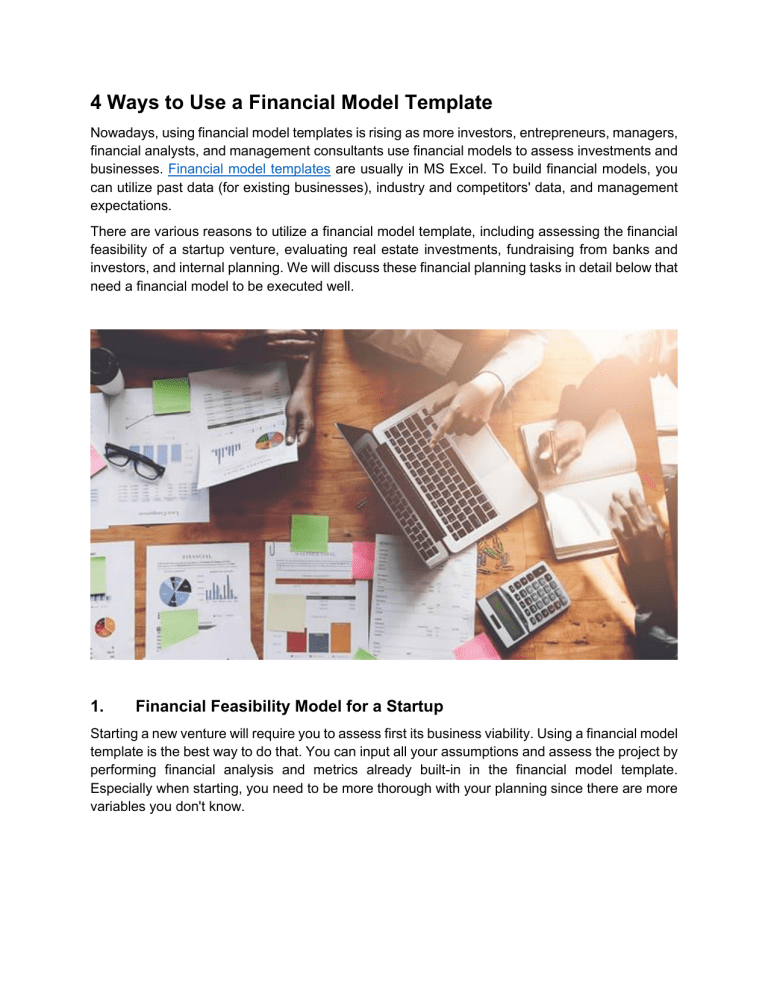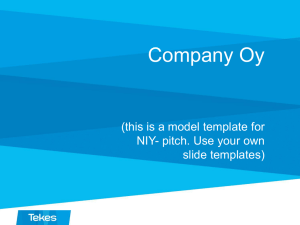
4 Ways to Use a Financial Model Template Nowadays, using financial model templates is rising as more investors, entrepreneurs, managers, financial analysts, and management consultants use financial models to assess investments and businesses. Financial model templates are usually in MS Excel. To build financial models, you can utilize past data (for existing businesses), industry and competitors' data, and management expectations. There are various reasons to utilize a financial model template, including assessing the financial feasibility of a startup venture, evaluating real estate investments, fundraising from banks and investors, and internal planning. We will discuss these financial planning tasks in detail below that need a financial model to be executed well. 1. Financial Feasibility Model for a Startup Starting a new venture will require you to assess first its business viability. Using a financial model template is the best way to do that. You can input all your assumptions and assess the project by performing financial analysis and metrics already built-in in the financial model template. Especially when starting, you need to be more thorough with your planning since there are more variables you don't know. 2. Evaluate Growth Scenarios for Business Expansion When planning for expansion, it is crucial to evaluate the existing data to base your business expectations. Do you have enough internal resources to finance the project? If not, where will you source out financing? You can present both the best- and worst-case scenarios to have a better perspective of the expansion project. Also, the graphs and charts in the financial model help you better understand financial economics leading to in-depth knowledge of your venture. 3. Utilize Various Real Estate Valuation Real estate valuation can be quite different to value than other business ventures. And there are specific model types you can utilize for your real estate investment projects. The approaches you can use are Capitalized Earnings Valuation, Comparable Property Analysis, DCF Model, Replacement Costs, and Residual Value. Utilizing more than two methods can produce more accurate results, especially if you do have enough data you can utilize. 4. Fundraising from Banks and Investors Presenting to banks and investors to acquire financing will require a financial plan showing the ability of the business to pay loans or distribute dividends. Most of the financial models have a Debt Schedule, including key financials, leverage ratios, loan facilities, balances, drawdowns, repayments, and interest. A Cash Flow for Investors Sheet is also helpful to assess the project's potential return and how much return should be reached to provide an Exit option for the investors. Moreover, you can assess business valuation pre and post fundraising. 5. Utilize for Internal Planning A financial model is an excellent tool for internal planning. It can help you prioritize projects and hold other projects once more resources free up. Company goals will become more tangible and achievable if presented in numbers. Since you have the business valuation in hand, you can set the business direction you want to take. You will have a firm anchor when setting business goals that are tangible to management and employees. You can now appreciate the importance of using a financial plan template after evaluating in detail its purpose and using it for your financial planning. Nowadays, small and large firms are already outsourcing financial model templates for their financial planning tasks. They appreciate the time and resources they can save when using a financial model template rather than preparing internally. eFinancialModels offers a variety of well-structured and industry-specific financial model templates to assist entrepreneurs, bankers, management consultants, and other business decision-makers in making their financial planning tasks easy and efficient.

